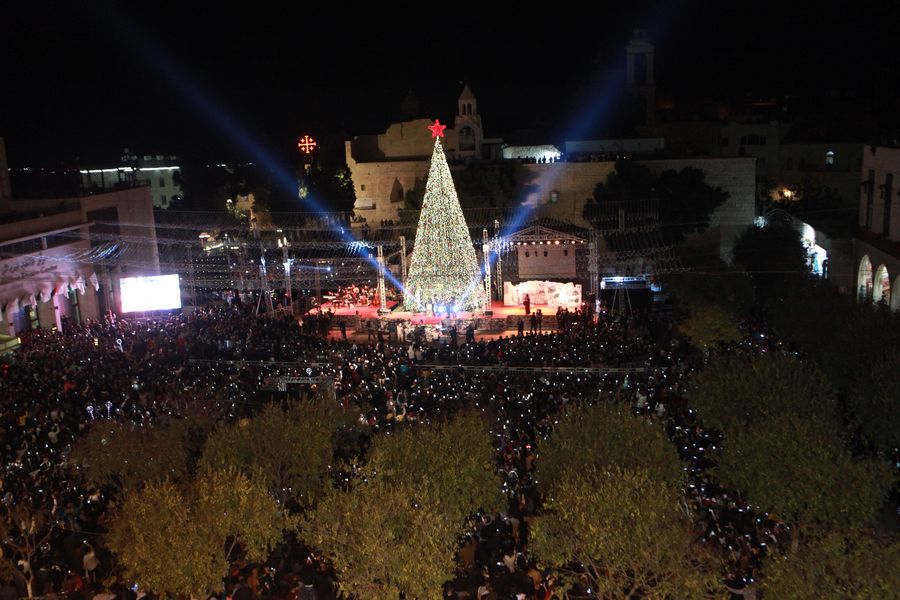
The main Christmas tree is lit up during a lighting ceremony at the Manger Square, in the West Bank city of Bethlehem, on Nov. 30, 2019. (Xinhua/Mamoun Wazwaz)
As a famous destination for pilgrims across the world, the Palestinian West Bank city of Bethlehem is witnessing the hustle and bustle of local people's preparation for the coming Christmas, though it's still suffering the Israeli settlement expansion for the moment.
by Fatima AbdulKarim
BETHLEHEM, Dec. 8 (Xinhua) -- The tourism-driven economy of the Palestinian West Bank city of Bethlehem thrives during the Christmas season, but Palestinians say they can hardly ignore the Israeli settlement expansion around the city during this year's preparations.
The overall area of the Palestinian district of Bethlehem, to the south of the West Bank, is 660 square km, out of which, Palestinians can only use 13 percent, because the rest is in area C, which is under full Israeli control.
Around 92 percent of the 210,000 population of the Bethlehem district is confined in the 13-percent area, according to the Bethlehem-based Palestinian NGO, the Applied Research Institute - Jerusalem, which warned of a total devastation of the city in light of the continuation of settlement expansion and land confiscation.
Settlement experts at the Institute say that the settlement expansion in the area is more problematic since it is accompanied by checkpoints and the separation wall that restrict access into the city.
"There are 23 settlements and 14 outposts that grab the land of Bethlehem, of course. This also takes to a second phase of devastation, which is the checkpoints, the terminals and the bypass roads, which are built to accommodate the settlers' ability to move freely. But, on the other hand, they work towards imprisoning and restricting the residents of Bethlehem," said SuhailKhalilieh, head of settlements monitoring department at the institute.
Khalilieh warned that once the Israeli built wall between Bethlehem and East Jerusalem is completed, about 27 percent of the district's land "will be isolated behind the wall, meaning that they will be out of reach, where Palestinians cannot access their land."
"This is how this city is devastated," he said.
Under the interim Oslo Agreement signed between the Palestine Liberation Organization (PLO) and the Israeli government in 1993, the West Bank was divided into three areas: Area A under Palestinian control, Area B under joint Palestinian-Israeli control, and Area C under full Israeli control.
The Oslo accords were supposed to expire after a five-year interim phase, where the entire West Bank area was to be given to Palestinian control. However, the Israeli settlement activity there continued and crippled the final status peace negotiations between Palestinians and Israelis.
Nevertheless, Anton Salman, mayor of Bethlehem city, seemed optimistic about this year's Christmas season, with the renovations in the Church of Nativity, which is believed to be the place of birth of Jesus Christ, coming to an end.
He told reporters that the numbers of visitors flocking into the city is increasing each year.
"I think 2020 numbers will be more than 2019 and as much as the city would continue as a stable with a secure situation, as much as it will encourage tourists to come to visit the city," he said.
More projects are underway in hope of attracting more tourists.
Despite the local efforts, tourism practitioner and experts complain of the increasing Israeli imposed restrictions that scale down the local economy and accessibility sharply.
"Within the Oslo agreement, zone C is an area where we can diversify the tourism projects for Palestinians, where we can go to Palestinian cultural heritage sites and develop it. But this development is very much limited because the Palestinian Authority is not allowed to go and excavate many of its cultural heritage sites for that reason; which is being in zone C, needing Israeli permission and the Israeli permissions are not issued,"said George Rishmawi, a local tourism expert and the executive director of a tourism company, named Abraham's Path.
"On the other hand, the Israelis are very much manipulating good part of Palestinian cultural heritage site," he said.
However, the main attraction to tourists from all over the world remains in the center of the city's main square, which is the Church of Nativity.
Believed to be standing atop of the grotto that has been considered the birthplace of Jesus Christ since the second century A.D., the church has been continuously receiving pilgrims since the 14th century. ■



